|
|
|
|
| Low-Level Photography Reports RTBA Tours - AJeTS Istres - Mirage 2000Ns Catalogue des Itinéraires |
| Military Low-Flying Training in France 'Low-Fly French Style' Le Réseau Très Basse Altitude (RTBA) (Rase-mottes d'avions de chasse de l'Armée de l'Air) |
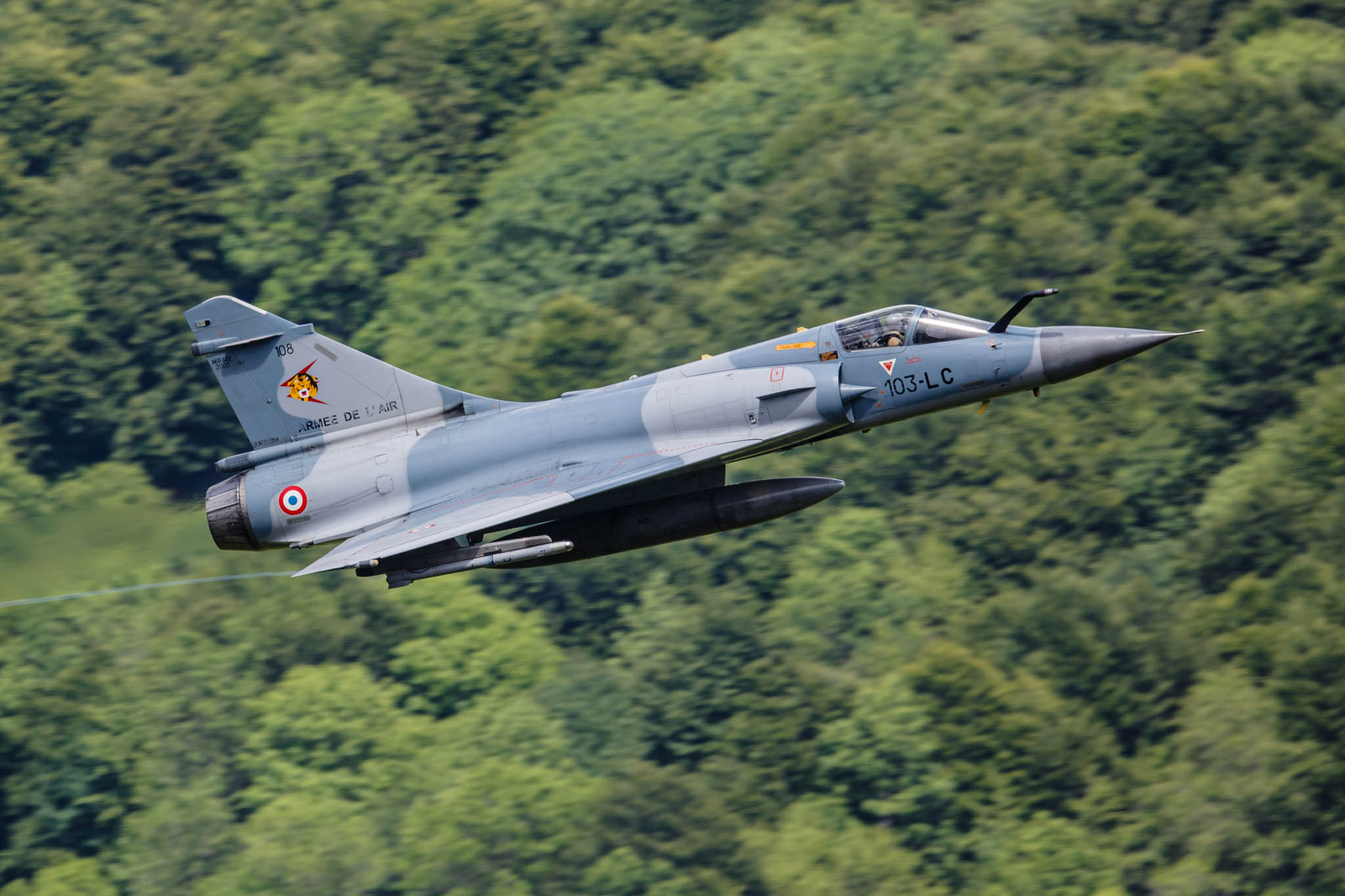 |
| Mirage 2000C (108 '103-LC') in the colours of EC 01.012 from when it was based at Cambrai-Epinoy (BA 103) in northern France. Now based in the south at Orange-Caritat (BA 115) with EC 02.005 they are within easy reach of the mountainous Auvergne region of the Massif Central where this aircraft was photographed. |
The RTBA corridors are all flowed one way for safety reasons, the direction is reversed every alternate day. The corridors are divided in to numbered sectors, a sequence of sectors are in operation only for a few hours each day. Activated at different times the availability of these time slots is negotiated with the civilian authorities. Despite the slots being made available to military pilots they are not always taken up by them for various reasons. The pilot’s training requirements, the weather on the day and the serviceability of the aircraft may dictate whether a slot is utilised. The RTBA map shows that each sector has a minimum and maximum height, typically 800 feet (244m) ASFC (Above Surface) to 2000 feet (610m) AFSC or SFC (Surface) to 4,000 feet (1,219m) AMSL (Above Mean Sea Level) for example. To ensure flight deconfliction one flight of up to two aircraft every three minutes is allowed in each sector. For a flight of four aircraft a six minute slot is allocated to allow a pair to break away from a four ship formation.
If the pilot has a problem and arrives one minute late or early at the sector entry point according to his low-level booking then he cannot continue his low level mission. Lt Col Coulomb asserts; “He then has to pull out of low-level, he cannot ask for permission to continue even if he is the only flight of the day, it is a very strict system for reasons of safety”. Radio contact with a local air traffic controller is compulsory at every sector entry point. There is no difference in rules between day and night (sunset to midnight), however night flying is only authorised on Tuesdays and Thursdays. The CDPGE are fully aware of the adverse affect of low-flying aircraft on the general populationand so the corridors are deliberately located away from the towns. In earlier times pilots were using just a map and could not fly a precise track, now using GPS their track is very precise and as a consequence the aircraft’s noise is always over the same places. In mid 2011 the CDPGE made some corridors wider to allow for more flight tracks within it to spread the noise. Lieutenant-Colonel Frédéric-Guillaume Ohrenstein, Commanding Officer of EC.02 the only Dassault Mirage 2000N squadron explained the need for and advantages of the RTBA corridors. “The corridors segregate the traffic and ensure the pilots can focus on TFR (Terrain Following Radar). You might assume that flying in these corridors the conditions are always going to be the same, this is not the case. The timings, the weather conditions and even the moon, as we use NVGs (night-vision goggles), make each mission different. You can also fly in each direction in the corridor, twelve to 15 missions with three to five tactical situations within them gives you at least 50 scenarios”. Combat training areas Positioned around the RTBA network there are six larger training areas (named Combrailles, Selune, Ardèche, Morvan, Drome and Aube) and a number of Restricted Areas (e.g. R68) or Romeo’s as pilots and controllers will call them. They are used for combat training and cover lower airspace from SFC to 11,500 feet (3,505m) AMSL they are found immediately above the corridors. Above the Romeo’s are further higher level combat training areas termed Temporary Segregated Areas (TSA) these are designated from 11,500 feet (3,505m) AMSL to an unlimited height. TSA’s are defined as an area for the exclusive use of a particular user during a determined period of time and through which other traffic will not be allowed to transit. Lt Col Coulomb described how these military training areas fit together; “We can combine two activities, a low-level mission through the corridors to simulate bombing a target with a Combat Air Patrol (CAP) mission above a corridor for air defence pilots, both areas will be reserved by the pilots over the same period to allow this”. Low-level flying training is not restricted to the RTBA corridors and combat training areas, pilots can also fly across France using ‘see and avoid’ under Visual Flight Rules (VFR). Outside controlled areas the French Military Rules of the Air allow fixed wing aircraft to fly at a minimum altitude of 500 feet (152m) ASFC (Above Surface) and at a maximum speed of 550 knots.
DIANE The CDPGE has developed sophisticated software named ‘DIANE’. It is used by controllers to manage the RTBA bookings. It covers only airspace reserved for military use from the surface to 66,000 feet (20,117m) and includes the low level corridors and the medium and upper airspace training areas. Pilots through the controllers utilise the software to locate free military airspace and make bookings to use it. The pilot’s booking can be made up to 16:00 on the day before, the booking comprises; the aircraft type, unit/air base, call-sign and the number of aircraft in the flight (1-4). A corridor entry point and entry time along with an exit point and exit time is agreed for each corridor sector. Priorities can be given to missions and squadrons if some equipment needs to be tested or for a particular low-level training requirement. DIANE categorises three types of aircraft associated by their speed; high speed aircraft such as Dassault Rafale, Dassault Mirage 2000B/C/D/N, turbo-prop transport aircraft such as Aérospatiale-MBB C-160 Transall and the slowest users the helicopters. The software simulates the low-level training missions, displaying the planned sorties moving through the corridors using a symbol or profile of the aircraft which is colour coded by type e.g. Mirage 2000D (blue), Mirage 2000N (white) and Rafale (Grey). Lt Col Coulomb remembers the old low-level booking system before it was fully computerised; “Previously the system used paper and Plexiglas, DIANE is an excellent system”. DIANE has a maximum of 100 low-level bookings per day within the RTBA. Lt Col Coulomb revealed that some years ago there could be up to 100 aircraft in the corridors daily, more recently it is down to 20-40 per day, due to cuts in aircraft numbers and pilots. Corridors and their sectors are activated for various times which vary from day to day. Not all corridors and low-flying areas are available to military pilots all the time. The flight information is published daily for the civil aviation information office to assist flight planning of civil VFR pilots enabling them to avoid the low-level corridors during the periods of activation. Linked to the DIANE software is a free-phone number which has a pre-recorded list of the day’s active corridors and the timings when they are in use. In June 2012 an enhancement to the system now enables the pilot to enter his low level bookings onto DIANE using his own computer terminal which is connected to the secure military Intranet. |
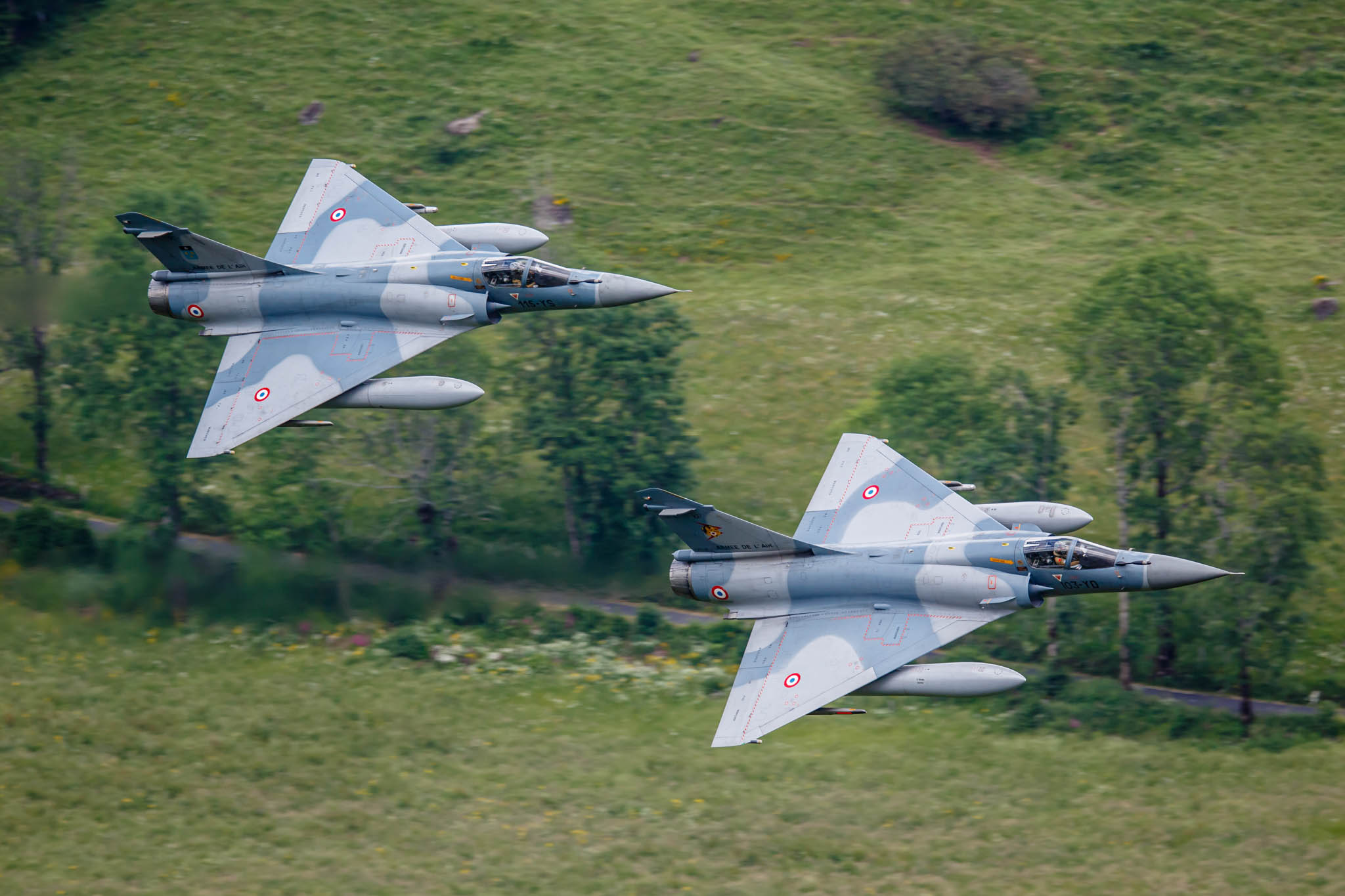 |
| Approximately 20% of Mirage 2000B/C flights are at low-level. Combat Air Support and air-to-ground strike training against targets with and without coordination with Army Forward Air Controllers are usually flown as a two-ship normally down to 500 feet (152m) AGL. Above: Mirage 2000Cs (90 '115-YS' with 107 '103-YD') of EC 02.005 'Ile de France' based at Orange-Caritat (BA 115). |
| Catalogue des Itinéraires A catalogue of 60 or more low-level routings or missions within the RTBA corridors has been produced by the CDPGE and has been agreed with the air bases which use the low-level booking system. Each routing has been given a code, (e.g. ‘AA04’ which is an anti-clockwise circular route in north-western France through corridor sectors R149A to R149G). The catalogue is designed to provide maximum flexibility and availability for all those wishing to fly at low-level with the minimum amount of confliction. As the corridors are always one way throughout the day the catalogue is split in half; with routes to be used on even numbered dates (Itinéraires pairs) and routes for the odd numbered dates (Itinéraires impairs). For example route ‘AA03’ uses the same corridors as ‘AA04’ and follows a clockwise direction and is in use only on odd numbered dates, while ‘AA04’ follows an anti-clockwise route and is active on even dates only.
A pilot can easily book a route by quoting the catalogue reference again up till 16:00 on the day before his sortie. The system is also sufficiently flexible to allow low-level routings outside the itineraries but require more input at the booking stage but requires six weeks notice. This enables CDPGE controllers to reserve the airspace and block affected catalogued routes from being booked.
Lieutenant-Colonel Julien Moreau is the new Commanding Officer (CO) of the Advanced Jet Training School (AJeTS) which is based at BA 705 Tours-St. Symphorien. He has the responsibility to make sure French Air Force (Armée de l' Air - Adl’A) students are able to pass to a frontline fighter squadron. He joined the French Air Force Academy in 1995 progressing to Colmar air base (BA 132) to fly the Dassault Mirage F.1CT in the ground attack role. In seven years he had clocked up 1,500 hours and he estimates between 50% and 70% was at low-level. With regular tours of duty to North Africa he has considerable experience in the CAS role. All Adl’A student pilots attending AJeTS strive to join a frontline fighter squadron and fly a Mirage or Rafale. The AJeTS pilot training program prepares them for the next stage in the development. As many students will eventually fly in the ground attack role many hours of the course are devoted to making the student feel comfortable in the low-level flying environment. A pool of 40 Dassault/Dornier Alpha Jet Es are divided between two squadrons at AJeTS. Currently there are 45 Instructor Pilots (IP) at AJeTS including one from 11 Squadron of the Belgian Air Component (COMOPSAIR). Following a review of its advanced jet training program COMOPSAIR decided to send its students from 2004 to AJeTS at Tours and Cazaux where its own Alpha Jets are now based. Around six to nine students from Belgium attend each course at Tours, French and Belgian IP’s train each others students. Low-level flying training in France for COMOPSAIR students is more effective in France as in Belgium there is a minimum height for low-flying jets of 1,000 feet (305m) apart from a small training area in the Ardennes. Flying lower and faster There are two main courses which run in parallel at AJeTS; the first is for 45 student pilots the second is for 15 trainee Weapons System Officers (WSO) or ‘wizzo’, they run for between six and seven months. Last year they delivered 35 students with wings and 13 WSOs. The pilot training course consists of 66 sorties which are designed to progressively get harder as they fly nearly 100 hours. Students arrive and attend ground instruction classes for two to three weeks before flying commences. During the basic flying training module each student is paired with an IP for the first four or five flights to help build their confidence in the early stages of the course. Initially they will be taught general flying, aerobatics and the handling of failures. Students are shown how to stay on track and to leave and get back on track. The first four sorties are at just 360 knots as before arriving at Tours student pilots will have flown the Grob G120 at only 150 knots and the WSOs on the Jodel D.140 at 110 knots. After around 15 hours of flying they will have two solo flights. During the basic flying module students are also instructed on weather avoidance. Major Alexandre Rey, Commander 1st Squadron; “We will fly towards bad weather which in France is not always easy, sometimes we have to simulate it and ask the student what he should do to avoid it during the flight”. Students are not permitted to fly below a cloud base of 1,000 feet (305m) as they must have a minimum of 500 feet (152m) AGL (Above Ground Level) above and below their aircraft and also at least 6.2 miles (10km) of visibility. They cannot fly through clouds at low-level unless they are under an Air Traffic Control radar controlled descent. The students are now ready for navigational training module most of the required 13 sorties are flown at 500 feet (152m) AGL and 420 knots, later they fly at 450 knots when attacking targets. Crew dialogue and co-operation is introduced with fuel management and Global Positioning System (GPS) for navigation. During the basic flying module the IP will not say anything unless asked and will only take control if the student is going to hit the ground. |
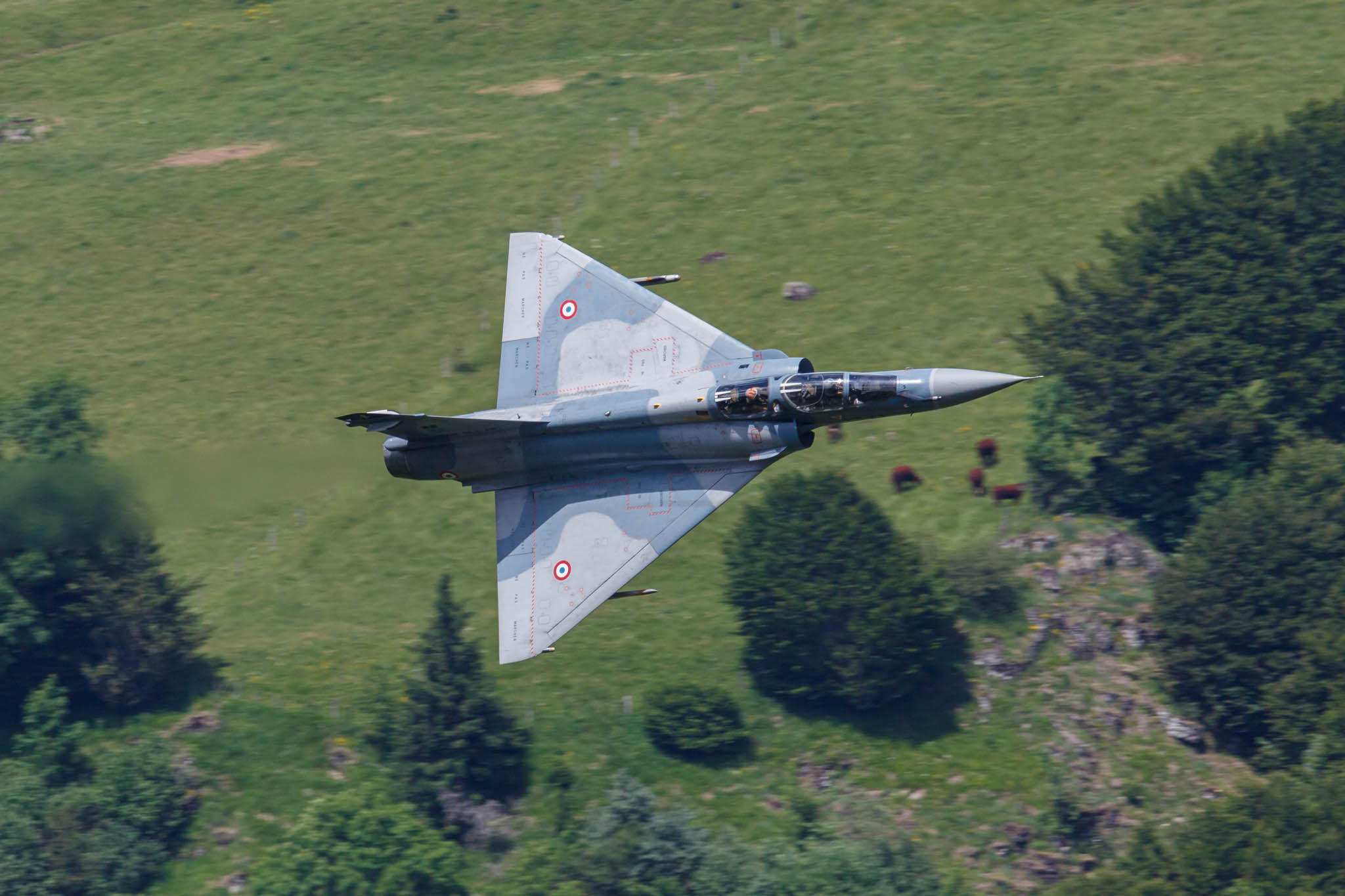 |
| Two-seat Mirage 2000B (523 '115-KJ') of EC 02.005 'Ile de France' based at Orange-Caritat (BA 115). Students graduating at the Ecole de transition Opérationnelle (ETO 008) with AJeTS at Cazaux (BA 120) and selected for the Mirage 2000 will first go to Orange-Caritat (BA 115) for 50 to 60 flight hours on the twin-stick Mirage 2000B and later to fly solo in the single seat Mirage 2000C before moving to a frontline Mirage 2000C-5F, 2000D or 2000N unit. Above: Two-seat Mirage 2000B (523 '115-KJ') of EC 02.005 'Ile de France' based at Orange-Caritat (BA 115). |
At every stage of a student’s training safety is the dominant element. An early morning weather briefing is conducted for all students flying that day, IP’s and the commanders gather in the main briefing hall. Students are informed of the days landing procedures and reminded of when to adjust throttle and deploy flaps. One student is asked to stand up front and a potential mechanical problem is thrown at him. His detailed answer should relate to all the appropriate safety procedures. The student’s IP for the day will go through a mission overview 30 minutes before the ‘step’ to the jet, discussing the weather and the mission in detail. For a low-level mission for example they will discuss failures, bird-strikes and collision avoidance. Out to the aircraft and 30 minutes is allocated for pre-flight checks. In the low-level flying environment when one crew member is looking down at his instruments he will inform the other crew member, to ensure there is always at least one crew member looking out for other aircraft. ‘Auto-Info’ is a single dedicated frequency for pilots to report their position, height and changes in headings along with their intensions, it is used at least every five minutes or at crossing points, so an aircraft on a conflicting track can climb or change heading. Impacting on the ground is the other obvious danger to pilots flying at low-level. Captain-Commandant D Lerberghe of the Belgian Air Component has been training students at Tours for four years. As a former General Dynamics F-16 Fighting Falcon pilot and having participated in Red Flags and Maple Flags for which progressive step down training necessary, he is fully aware of the dangers of flying fast and low; “You have to be vigilant when flying at low-level, aware of visual illusions. I have been shown a video where the pilot focussed on a large distant hill and impacted on a smaller but nearer hill”. Safety measures are not just for the students, Captain Joel Chambourdon a Mirage 2000N WSO has the additional responsibility of being Flight Safety Officer for EC.02; “I have to stand back from the squadron to see what is going right and wrong, my role is to see if there are any safety issues which are discussed during the morning briefing.
The weather briefing will dictate which areas if any are available for low-level flying. At the beginning of the AJeTS course the IP will explain how to reach the target, students are not given a time they just have to learn to find the target and over-fly it. The advanced student may have to prepare to attack two targets, the task for each target could be to bomb, to photograph or just over-fly it. Later they may be told for example that the run in will last one minute and 30 seconds starting from an initial point to the target. During the Advanced module they are given timings they have to keep. To further add to the complexity of later missions, students will be given an aircraft failure along the route and a diversion exercise must be exercised. The student has to think where this failure maybe and plan where to divert to. One hour 45 minutes is allocated to the student for planning their sorties. Mission planning software is utilised by the students, here the flight track or route is entered by clicking points on a large scale digital map. After keying in additional details of the mission such as; speeds, diversion airfields and targets the mission data is download to a GPS unit which is taken out to the aircraft for the sortie.
During the navigational training phase high-low-high profile sorties are flown in preparation for the low-level deep penetration missions flown by front line strike squadrons. Students depart high to later descend to low-level over an airfield en-route to a target before climbing out for a high level transit to return to base (RTB). IP Major Xavier Hirschauer described a High-Low-High sortie he was about to instruct on; “We are flying on a mixed profile, departing high before descending down with another airfield to perform low level navigation behind simulated enemy lines before an RTB at medium or high level depending on fuel. This is to combine different types of navigation with high and low-level flight to perform a strike. Students will deal with technical situations such as the entry gates and the simulated threats in the area such as an airfield”. The aircraft for this sortie was fitted with drop tanks to extend its duration to one hour 30 minutes and enabling 40 minutes of low-level navigation. Standing by a military flight map of France, Maj Hirschauer continued with the student’s flight briefing; “I will now give him the targets and the technical situation so he can work out the track and the timings for the mission, the target today is near Clermont Ferrand”. The AJeTS pilot training course concludes with a formation flying training followed by four night-flying sorties none of which are at low-level ending with twelve sorties of instrument flying. AJeTS staff will work hard to prepare students for the next stage of their development and achieve their dream to become a jet fighter pilot. For the few students that fail to make the grade most will be put onto the transport and helicopter training courses. The successful students will move to Ecole de transition Opérationnelle (ETO 008) with AJeTS at Cazaux (BA 120) for continuity training on the Alpha Jet, where they go further with navigational training and weapon delivery. At Tours the student advises the IP if he is early or late whereas at Cazaux the student has to match the flight timings with the reference time on the flight plan. The work in the cockpit is ramped up with basic tactical scenarios and a time on target (TOT) of plus or minus 30 seconds. Later AJeTS students may return from their frontline squadron to become instructors and impart their considerable knowledge and experience for the benefit of the next generation of students. |
| The Rafale - A new shape in the valleys |
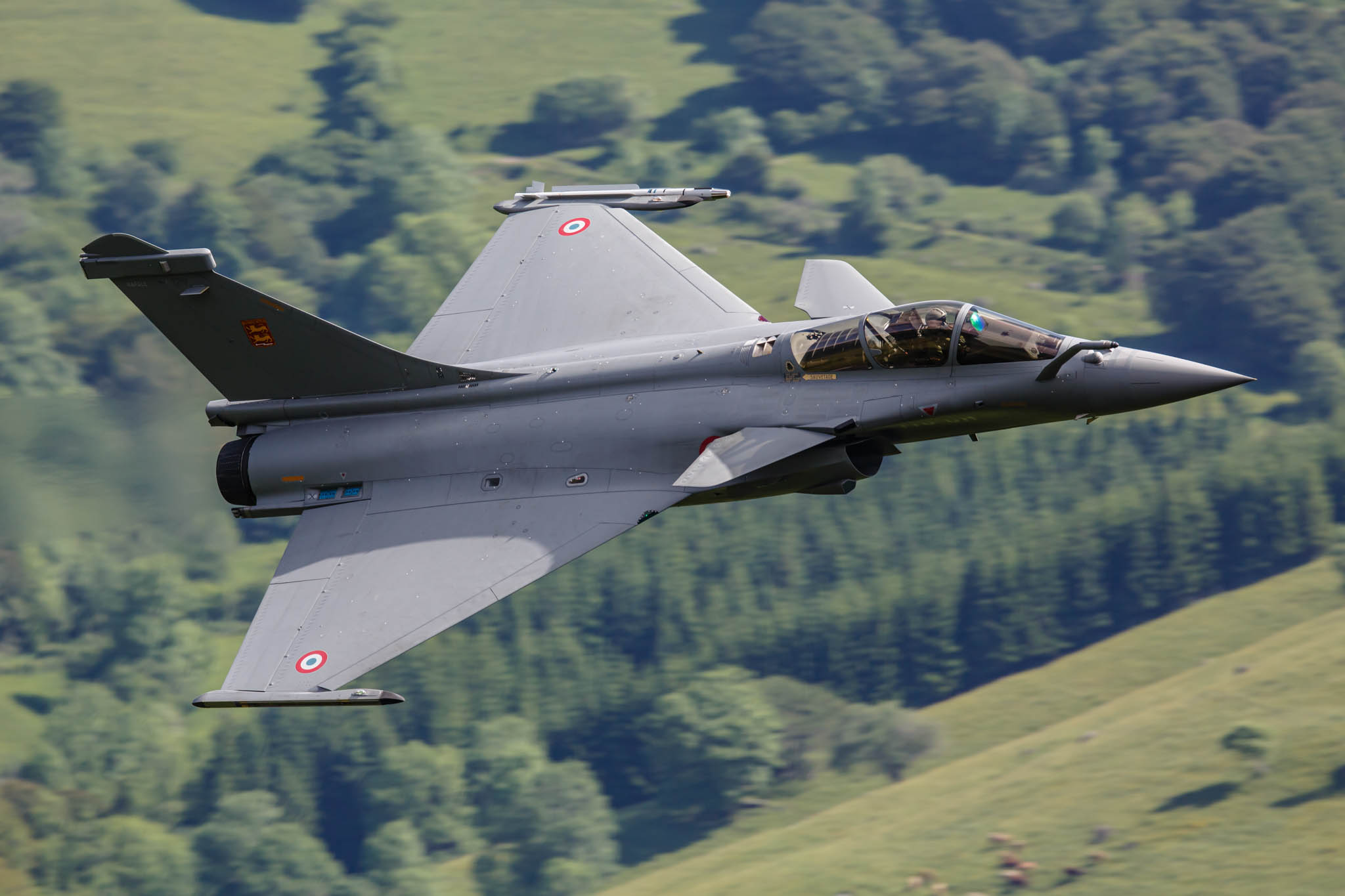 |
| Dassault Rafale C (129 '118-GH') in the markings of Escadron EC 02.030 'Normandie-Niemen') on a low-level training flight. Just a few days later on June 25, 2012 the unit was declared fully operational at BA 118 Mont-de-Marsan. The first of 212 Rafale B/Cs on order entered service with EC 01.007 at BA 113 St.Dizier-Robinson in 2005 becoming fully operational in 2007, deliveries to the Armée de l'Air should continue until 2015. The Rafale is a true multi-role fighter capable of; air defence, close air support, interdiction, reconnaissance and nuclear deterrence. It has been designed to fly using either an air-to-air or air-to-ground mode, uniquely this mode is switchable in flight with the press of a button. A warning will alert the pilot to targets on the ground when flying using the air-to-air mode and vice versa. This capability is made possible by the Thales RBE-2 radar which will look-up and look-down to detect and track multiple air targets, in all weather and in a jammed environment. It also has the ability to generate of three-dimensional high resolution maps for terrain-following above uncharted terrain in blind conditions for navigation and targeting in real time. An enhanced radar using a Active Electronically Scanned Array (AESA) was installed in a test aircraft (Rafale serial 137) in February 2012. It is anticipated that the Armée de l'Air will have five AESA equipped aircraft operational by the end of 2013. |
Students successfully completing the AJeTS course will progress to a frontline squadron after an aircraft type conversion course. For either the Air Defence or the Strike role low-level flying will feature as part of their ongoing training. Students selected to fly the Mirage 2000C/D/N will transfer to Orange-Caritat (BA 115). The conversion training course consists 50 to 60 flight hours on the twin-stick Mirage 2000B and later solo on the single seat Mirage 2000C.Pilots will learn the basics; landing, take-off, instrument flight, formation flying, dog-fights and low-level flying. Low-level flying conversion on the Mirage 2000 enables the pilot to handle a single engine delta wing aircraft with large fuel tanks and heavy external loads for the first time.
Air-to-ground strike training is normally flown at 500 feet (152m) AGL initially to instruct pilots to fly safely at low-level incorporating, dead reckoning, failure management and fuel management. These sorties are usually flown with two jets. Later attacks on ground based targets and instruction on low-level penetration is introduced to the more experienced pilots. Flights of one or two aircraft in the Defensive Counter Air (DCA) and Offensive Counter Air (OCA) role are pitched against each other. All sorties can be flown entirely at low-level or with a high-low profile, or even a high-low-high profile depending on fuel requirements to complete the sortie. CAS missions in coordination with Army Forward Air Controller units who provide guidance to the aircraft for the strike are also flown as a two-ship. A briefing prior to the mission between the air and ground units is conducted to determine their respective training objectives. A post flight debriefing enables all parties to learn from each other. Low-level strafing runs using two DEFA 30mm cannon are also flown, pilots will fly with dive angles from 5° to 30° depending on the type of attack tasked. Pilots have to adapt to different dive angles and shooting distances which have to be varied to avoid the risk of shell rebounds. On completing the course pilots will move to the Mirage 2000-5F for Air Defence or to the Mirage 2000D or Mirage 2000N for the air-to-ground strike role. Pilots progressing to the Mirage 2000N which are now all based at Istres-Le Tubé air base (BA 125) will find that 60% of their flying hours are at low-level. It takes a further year of training before pilots become combat ready. The Mirage 2000Ns primary role is nuclear strike, flying fast and low under Radar coverage to avoid detection deep in to enemy territory. The Mirage 2000N is optimised for high speed at low-level utilising TFR for all weather operations day or night. Lt Col Ohrenstein the Mirage 2000N squadron Commanding Officer has the responsibility to make sure his aircrew are trained to an optimum level of performance. “The paradox of the nuclear mission is that it is successful if it doesn’t happen, my responsibility is to guarantee everything works”. The mission is very demanding crews fly 180 hours per year most is at low-level. “Peace time rules allow us to fly at 550 knots and 250 feet (76m) it is very dangerous, we are flying just five seconds from the ground and mistakes can happen. We lost one crew in March 2011 so we are very careful about this risky mission but that is our business”. Usually low-level training sorties have a TFR phase of at least between ten and 15 minutes. The TFR system provides built in safety and will automatically pull the aircraft up if anything goes wrong. Only the WSO knows where the obstacles are by following the track on his moving map screen. The pilot just looks ahead as does the TFR which will look to the side in the turn. Lt Col Ohrenstein said; “It can be frightening flying TFR at night, you can’t see the mountains but you know they are there. The aircraft is flying itself while the pilot has a soft hand on the stick ready to react should anything go wrong”. |
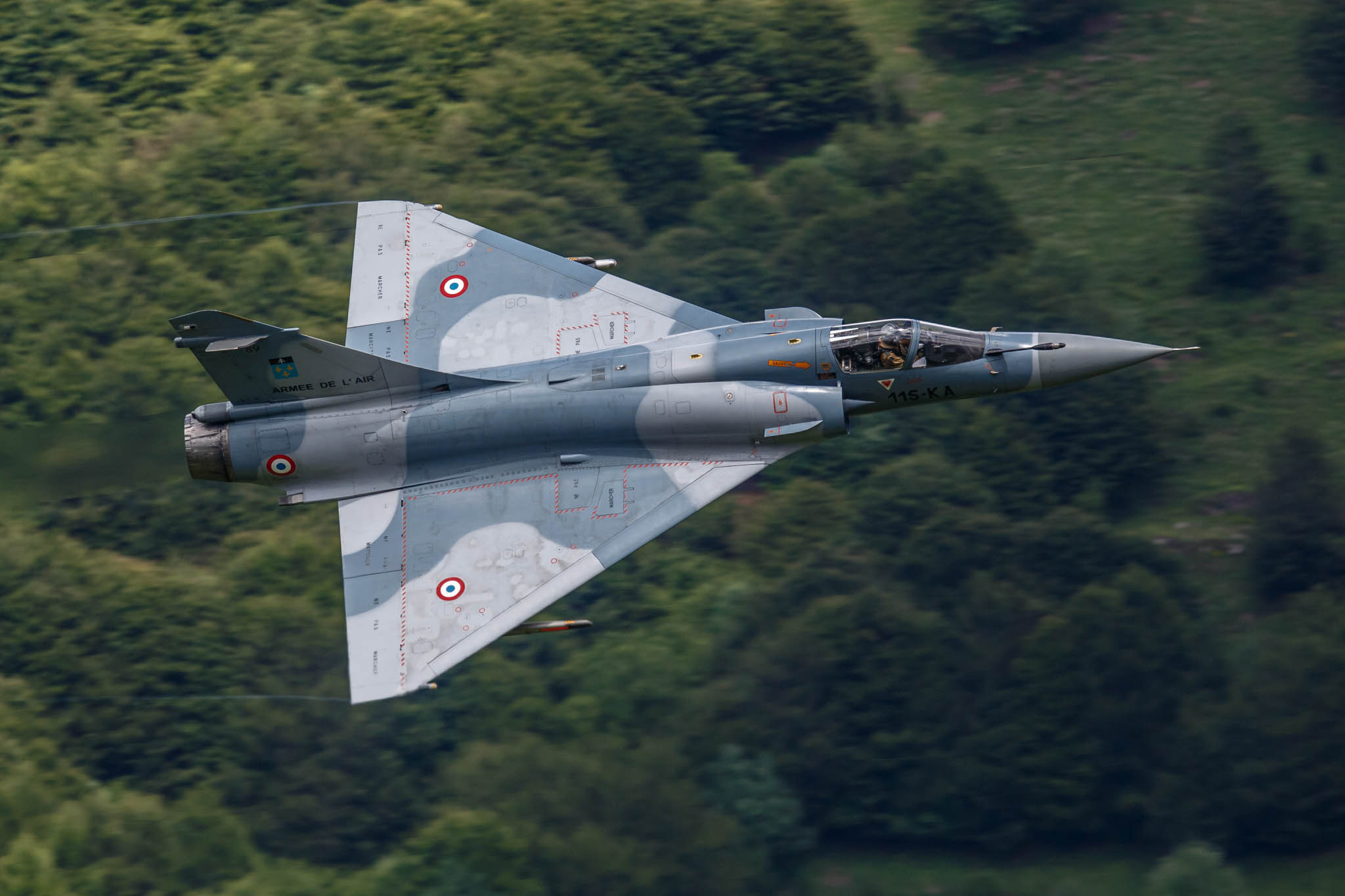 |
| Mirage 2000C (89 '115-KA') of EC 02.005 'Ile de France' based at Orange-Caritat (BA 115). |
To demonstrate the need for constant ongoing low-level training to maintain the high level of skill required to fly at low-level to protect ground forces, Lt Col Moreau described an operation which was assigned to him with just hours notice and so his squadron had no time to work-up for it. In 2003 General Bozize seized power from the unpopular Central African Republic president Ange-Felix Patasse. However following elections in 2005 he became the country’s democratically elected head of state. All was not well as a force of rebels persisted in disrupting the nation’s stability. In November 2006 Gen Bozize called to France for military assistance to counter the rebels. By mid-November the French government sent reinforcements of 100 men to join a detachment of about 200 French soldiers in Bangui. As the rebels were threatening forces on the ground the decision was made to immediately deploy the Mirage F.1CT for the CAS role. Lt Col Moreau remembers; “I was informed on a Sunday at Colmar that I would be going to Chad that night, wow!” The Adl’A had periodically deployed to N'Djamena in Chad which borders the Central African Republic under Operation Épervier (Sparrow Hawk) since 1986. “The operations were intense I arrived at night over the in Central African Republic flying at low-level with NVGs to locate the rebels”. A Show of Forcee To reduce casualties on the ground pilots will fly fast and low over a hostile ground force fast with what is termed a ‘show of force’. The aim is to demonstrate clearly and very loudly that if the hostiles don’t withdraw then they are in mortal danger. Major Fabre Thierry, Commander of 2nd Squadron at AJeTS said; “You don’t really want to bomb, a show of force is a way of saying hello, watch out we are here. It is proven to be effective to scare people away from attacking our troops”. The Adl’A will normally conduct a show of force at 250 feet (76m) AGL however sometimes it is below this, Lt Col Moreau explains; “In a threat environment then fast [550 knots] and lower than 250 feet (76m) is better as they can shoot at you with small arms. Pre-emptive flares are used for self-protection as there were reports of ground to air missiles in the area”. In the Central African Republic the rules of engagement were; one show of force before employing weapons, initially as a warning shot. Weapons could only be used for self-defence extending to protect troops on the ground. For anything else you need approval from the JFAC (Joint Force Air Commander) at N'Djamena”. To perform a show of force it will severely test a pilot’s skill and so pilots need to train regularly. Lt Col Moreau; “When you see a landscape from 15,000 feet (4,572m) it appears very flat, when you descend the relief comes up towards you. You have to prepare for your run in for a show of force. You descend very quickly to a point five miles short of the target. This is where you need your low-level skills you have to adapt quickly to the change in landscape. In the decent you lose sight of the target you recover it with the help of your HUD (head-up display) and a dot which represents the target”. |
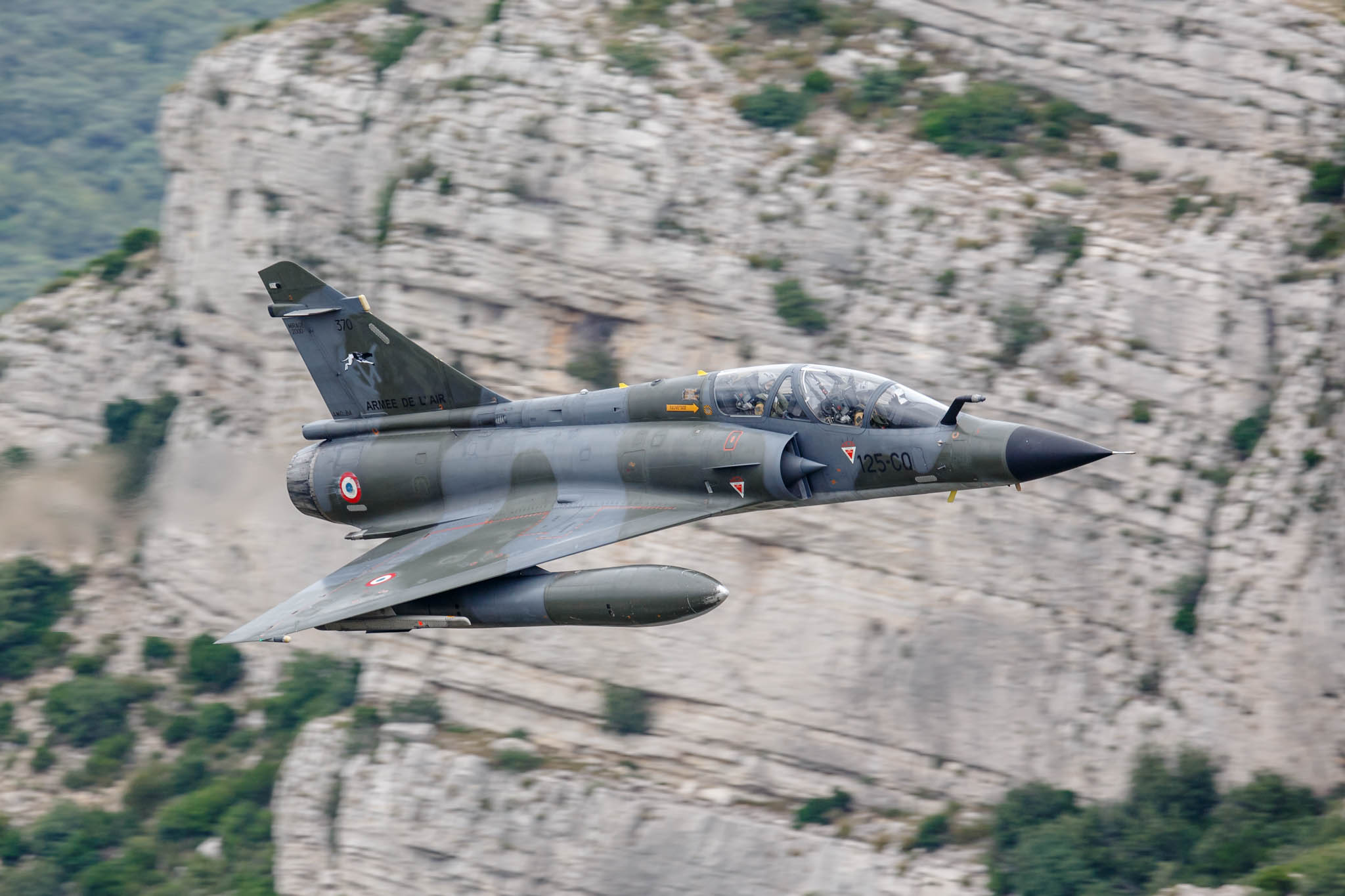 |
| A Mirage 2000N (370 '125-CQ') of EC 02.004 'La Fayette' it is just ten minutes flying time from its home base of Istres-Le Tubé (BA 125) near to the Mediterranean coast in the mountainous Provence region near to Mont Vontoux at 6,273 feet (1,912 meters). All Mirage 2000Ns are now based at Istres-Le Tubé air base in the south of France their pilots will fly 60% of their hours at low-level. "Peace time rules allow us to fly at 550 knots and 250 feet (76m), it is very dangerous, we are flying just five seconds from the ground and mistakes can happen. We lost one crew in March 2011 so we are very careful about this risky mission but it is our business", explained the EC.02 Squadron's commanding officer Lt Col Ohrenstein. |
It is often not easy to identify a target during CAS operations and distinguishing your own ground forces from those that wish them harm. During the Central African Republic conflict a village supported combined French and Central African Republic forces was under threat by the rebels to the north. A Bréguet ATL-2 Atlantique had been on station above the area all night. Lt Col Moreau describes his mission; “We were called in at first light, to identify the target took some time, the ground was a desert scrubland. We were at 10,000 feet (3,048m) AGL. The AFAC (Airborne Forward Air Controller) in the Atlantique cleared us for a show of force. We rapidly descended to five miles (8 km) from the point for the run in. The show of force was reported to have had no effect so the next pass was a bombing run as directed by the JTAC (Joint Terminal Attack Controller) on the ground. A benefit of using a show of force first is that identification of the target is very difficult in that environment, the FAC will advise you on the radio ‘right overhead’ which gives you further confidence that you know where the target is”. Respect the people on the ground Civilian and military traffic are competing for space to fly, airspace is becoming more and more congested as every year goes by. The military are well aware that they have to be considerate and keep disturbance of civilians to a minimum. Low flying times are restricted and pilots are taught not to over-fly towns, which are colour coded on the chart to signify minimum limits of say; 1,000 feet (305m) or 3,300 feet (1,006m) or 5,000 feet (1,524m) for larger conurbations. During the Skiing season you can’t fly low over the ski centres between November 1 and April 30. Lt Col Ohrenstein commented; “If you want to preserve low-level flying it is important that you respect the people on the ground, we respect all height and speed restrictions”. The unique French system of corridors with computerised airspace bookings developed over many years works very well. Military air traffic can reserve space to fly fast and low in relative safety, any part of the RTBA corridors not booked is automatically available to civilian pilots who can easily see where they can fly using information posted on the Internet the day before. |
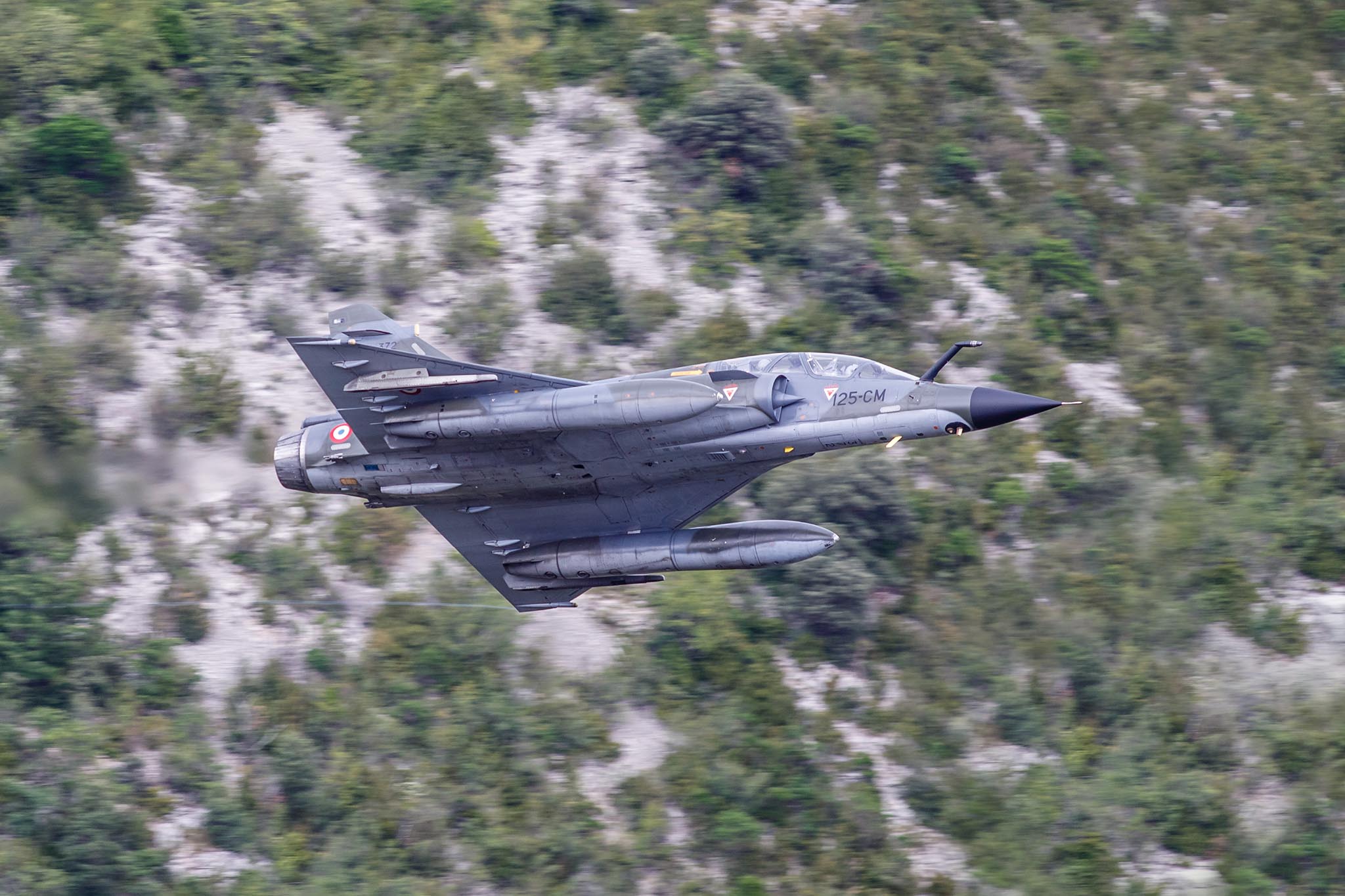 |
| Mirage 2000N (372 '125-CM') of EC 02.004 'La Fayette' based at Istres-Le Tubé on a solo low-level strike training sortie in the Cevennes region in southern France. Nuclear strike is the primary role of the Mirage 2000N, flying fast and low deep in to enemy territory under enemy Radar coverage to avoid detection. It has been optimised for high speed at low-level utilising Terrain Following Radar (TFR) to enable all weather operations day or night. |